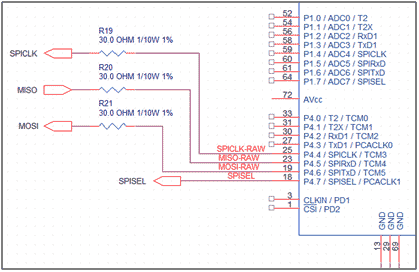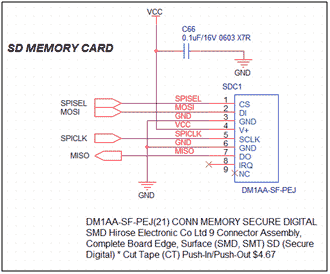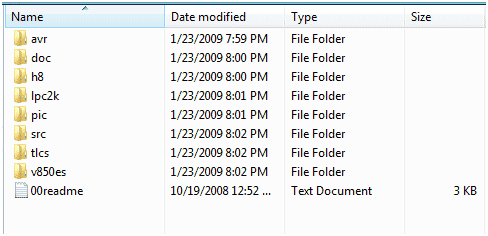Final Code : MMC SD Card interfacing
►Final Code
Using these functions, along with Chan’s tff.c module creates all the tools you need to read and write to a FAT16 SD card. An example program to display the root directory of the SD card would look like this:
►Final Code
Using these functions, along with Chan’s tff.c module creates all the tools you need to read and write to a FAT16 SD card. An example program to display the root directory of the SD card would look like this:
CODE:
#include "integer.h"
#include "tff.h"
#include "diskio.h"
FATFS SDCard;
void ShowDirectory( char *path );
char *ShowFatTime( WORD ThisTime );
char *ShowFatDate( WORD ThisDate );
DWORD get_fattime();
void main()
{
/* 1) mount drive... */
if( f_mount( 0, &SDCard ) )
{
printf("Couldn't mount drive...\r\n");
while( 1 );
}
/* 2) initialize card... */
if( disk_initialize( 0 ) & STA_NOINIT )
{
switch( CardType )
{
case 0 :
printf("Couldn't find SD card\r\n");
break;
case 1 :
printf("Card type is MMC - Can't use this type\r\n");
break;
case 2 :
printf("Couldn't initialize SD Card drive...\r\n");
break;
default :
printf("Unknown Card Type error...\r\n");
break;
}
while( 1 );
}
/* 3) show directory... */
ShowDirectory("");
while( 1 );
}
void ShowDirectory( char *path )
{
FILINFO finfo;
DIR dirs;
FATFS *fs;
DWORD clust;
ULONG TotalSpace, FreeSpace;
FRESULT res;
char VolumeLabel[12];
if(disk_read(0, SDCard.win, SDCard.dirbase, 1) != RES_OK)
{
printf("\r\nCouldn't read directory sector...\r\n");
return;
}
strncpy( VolumeLabel, &SDCard.win, 11 );
VolumeLabel[ 11 ] = 0x00;
if( f_opendir(&dirs, path) == FR_OK )
{
if( VolumeLabel[0] == ' ' )
printf("\r\n Volume in Drive C has no label.\r\n");
else
printf("\r\n Volume in Drive C %s\r\n", VolumeLabel );
printf(" Directory of C:\%s\r\n\n", path );
while( (f_readdir(&dirs, &finfo) == FR_OK) && finfo.fname[0] )
{
putchar('[');
putchar(( finfo.fattrib & AM_RDO ) ? 'r' : '.');
putchar(( finfo.fattrib & AM_HID ) ? 'h' : '.');
putchar(( finfo.fattrib & AM_SYS ) ? 's' : '.');
putchar(( finfo.fattrib & AM_VOL ) ? 'v' : '.');
putchar(( finfo.fattrib & AM_LFN ) ? 'l' : '.');
putchar(( finfo.fattrib & AM_DIR ) ? 'd' : '.');
putchar(( finfo.fattrib & AM_ARC ) ? 'a' : '.');
putchar(']');
printf(" %s %s ",
ShowFatDate(finfo.fdate), ShowFatTime( finfo.ftime ));
printf("%s %6ld %s\r\n", (finfo.fattrib & AM_DIR)?"<DIR>":" ",
finfo.fsize, finfo.fname );
}
}
else
{
printf("The system cannot find the path specified.\r\n");
return;
}
printf("%cCalculating disk space...\r", 0x09 );
// Get free clusters
res = f_getfree("", &clust, &fs);
if( res )
{
printf("
f_getfree() failed...\r\n");
return;
}
TotalSpace = (DWORD)(fs->max_clust - 2) * fs->csize / 2;
FreeSpace = clust * fs->csize / 2;
printf("%c%lu KB total disk space.\r\n", 0x09, TotalSpace );
printf("%c%lu KB available on the disk.\r\n", 0x09, FreeSpace );
}
char *ShowFatTime( WORD ThisTime )
{
char msg[12];
BYTE AM = 1;
int Hour, Minute, Second;
Hour = ThisTime >> 11; // bits 15 through 11 hold Hour...
Minute = ThisTime & 0x07E0; // bits 10 through 5 hold Minute... 0000 0111 1110 0000
Minute = Minute >> 5;
Second = ThisTime & 0x001F; //bits 4 through 0 hold Second... 0000 0000 0001 1111
if( Hour > 11 )
{
AM = 0;
if( Hour > 12 )
Hour -= 12;
}
sprintf( msg, "%02d:%02d:%02d %s", Hour, Minute, Second*2,
(AM)?"AM":"PM");
return( msg );
}
char *ShowFatDate( WORD ThisDate )
{
char msg[10];
int Year, Month, Day;
Year = ThisDate >> 9; // bits 15 through 9 hold year...
Month = ThisDate & 0x01E0; // bits 8 through 5 hold month... 0000 0001 1110 0000
Month = Month >> 5;
Day = ThisDate & 0x001F; //bits 4 through 0 hold day... 0000 0000 0001 1111
sprintf( msg, "%02d/%02d/%02d", Month, Day, Year-20);
return( msg );
}
DWORD get_fattime()
{
RTC_CURRENT rtc;
RTC_read( &rtc );
return ((DWORD)((WORD)(rtc.Year) + 20) << 25)
| ((DWORD)rtc.Month << 21)
| ((DWORD)rtc.Date << 16)
| ((DWORD)rtc.Hours << 11)
| ((DWORD)rtc.Minutes << 5)
| ((DWORD)rtc.Seconds >> 1);
}
#include "tff.h"
#include "diskio.h"
FATFS SDCard;
void ShowDirectory( char *path );
char *ShowFatTime( WORD ThisTime );
char *ShowFatDate( WORD ThisDate );
DWORD get_fattime();
void main()
{
/* 1) mount drive... */
if( f_mount( 0, &SDCard ) )
{
printf("Couldn't mount drive...\r\n");
while( 1 );
}
/* 2) initialize card... */
if( disk_initialize( 0 ) & STA_NOINIT )
{
switch( CardType )
{
case 0 :
printf("Couldn't find SD card\r\n");
break;
case 1 :
printf("Card type is MMC - Can't use this type\r\n");
break;
case 2 :
printf("Couldn't initialize SD Card drive...\r\n");
break;
default :
printf("Unknown Card Type error...\r\n");
break;
}
while( 1 );
}
/* 3) show directory... */
ShowDirectory("");
while( 1 );
}
void ShowDirectory( char *path )
{
FILINFO finfo;
DIR dirs;
FATFS *fs;
DWORD clust;
ULONG TotalSpace, FreeSpace;
FRESULT res;
char VolumeLabel[12];
if(disk_read(0, SDCard.win, SDCard.dirbase, 1) != RES_OK)
{
printf("\r\nCouldn't read directory sector...\r\n");
return;
}
strncpy( VolumeLabel, &SDCard.win, 11 );
VolumeLabel[ 11 ] = 0x00;
if( f_opendir(&dirs, path) == FR_OK )
{
if( VolumeLabel[0] == ' ' )
printf("\r\n Volume in Drive C has no label.\r\n");
else
printf("\r\n Volume in Drive C %s\r\n", VolumeLabel );
printf(" Directory of C:\%s\r\n\n", path );
while( (f_readdir(&dirs, &finfo) == FR_OK) && finfo.fname[0] )
{
putchar('[');
putchar(( finfo.fattrib & AM_RDO ) ? 'r' : '.');
putchar(( finfo.fattrib & AM_HID ) ? 'h' : '.');
putchar(( finfo.fattrib & AM_SYS ) ? 's' : '.');
putchar(( finfo.fattrib & AM_VOL ) ? 'v' : '.');
putchar(( finfo.fattrib & AM_LFN ) ? 'l' : '.');
putchar(( finfo.fattrib & AM_DIR ) ? 'd' : '.');
putchar(( finfo.fattrib & AM_ARC ) ? 'a' : '.');
putchar(']');
printf(" %s %s ",
ShowFatDate(finfo.fdate), ShowFatTime( finfo.ftime ));
printf("%s %6ld %s\r\n", (finfo.fattrib & AM_DIR)?"<DIR>":" ",
finfo.fsize, finfo.fname );
}
}
else
{
printf("The system cannot find the path specified.\r\n");
return;
}
printf("%cCalculating disk space...\r", 0x09 );
// Get free clusters
res = f_getfree("", &clust, &fs);
if( res )
{
printf("
f_getfree() failed...\r\n");
return;
}
TotalSpace = (DWORD)(fs->max_clust - 2) * fs->csize / 2;
FreeSpace = clust * fs->csize / 2;
printf("%c%lu KB total disk space.\r\n", 0x09, TotalSpace );
printf("%c%lu KB available on the disk.\r\n", 0x09, FreeSpace );
}
char *ShowFatTime( WORD ThisTime )
{
char msg[12];
BYTE AM = 1;
int Hour, Minute, Second;
Hour = ThisTime >> 11; // bits 15 through 11 hold Hour...
Minute = ThisTime & 0x07E0; // bits 10 through 5 hold Minute... 0000 0111 1110 0000
Minute = Minute >> 5;
Second = ThisTime & 0x001F; //bits 4 through 0 hold Second... 0000 0000 0001 1111
if( Hour > 11 )
{
AM = 0;
if( Hour > 12 )
Hour -= 12;
}
sprintf( msg, "%02d:%02d:%02d %s", Hour, Minute, Second*2,
(AM)?"AM":"PM");
return( msg );
}
char *ShowFatDate( WORD ThisDate )
{
char msg[10];
int Year, Month, Day;
Year = ThisDate >> 9; // bits 15 through 9 hold year...
Month = ThisDate & 0x01E0; // bits 8 through 5 hold month... 0000 0001 1110 0000
Month = Month >> 5;
Day = ThisDate & 0x001F; //bits 4 through 0 hold day... 0000 0000 0001 1111
sprintf( msg, "%02d/%02d/%02d", Month, Day, Year-20);
return( msg );
}
DWORD get_fattime()
{
RTC_CURRENT rtc;
RTC_read( &rtc );
return ((DWORD)((WORD)(rtc.Year) + 20) << 25)
| ((DWORD)rtc.Month << 21)
| ((DWORD)rtc.Date << 16)
| ((DWORD)rtc.Hours << 11)
| ((DWORD)rtc.Minutes << 5)
| ((DWORD)rtc.Seconds >> 1);
}


